overheating MERCEDES-BENZ ML430 1997 Complete Owner's Manual
[x] Cancel search | Manufacturer: MERCEDES-BENZ, Model Year: 1997, Model line: ML430, Model: MERCEDES-BENZ ML430 1997Pages: 4133, PDF Size: 88.89 MB
Page 2665 of 4133
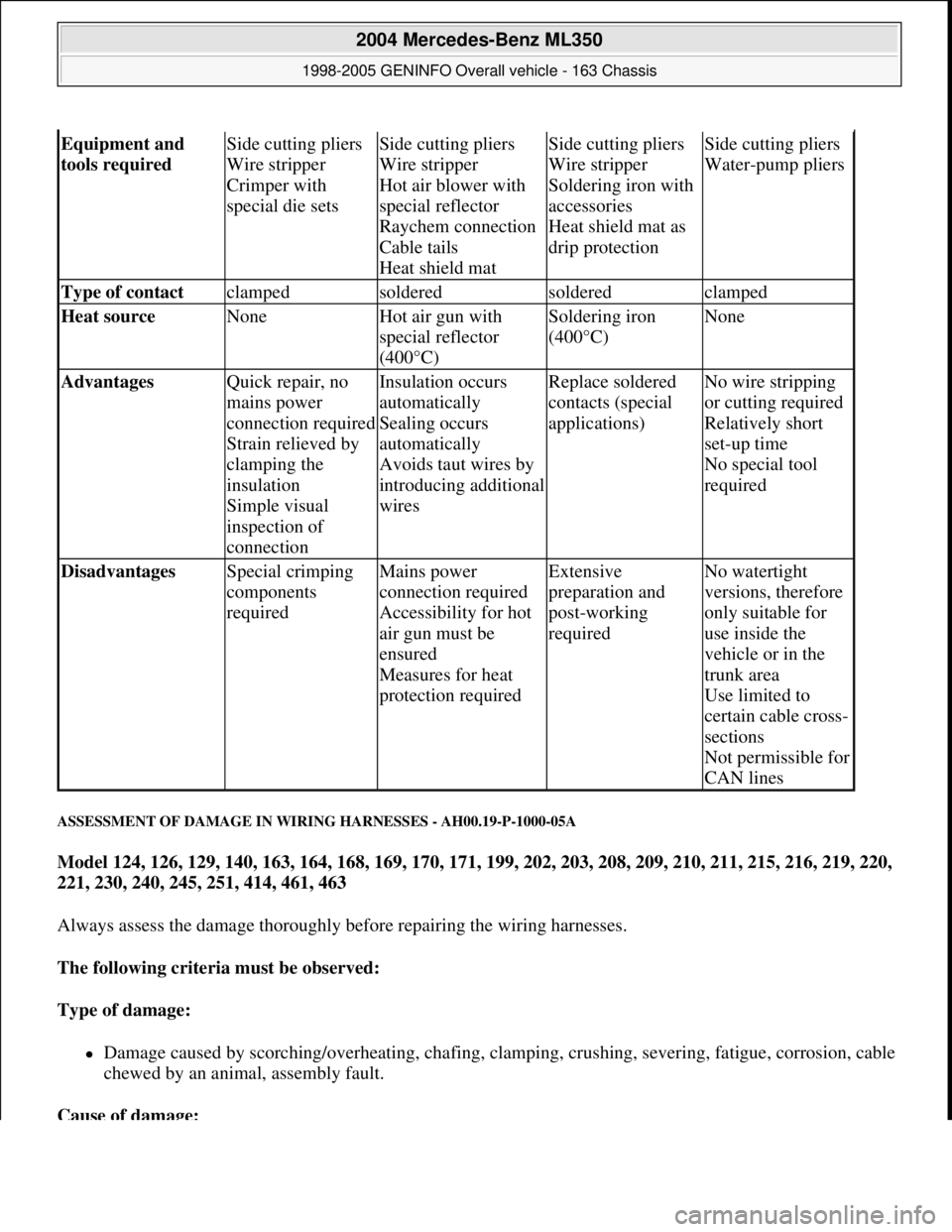
ASSESSMENT OF DAMAGE IN WIRING HARNESSES - AH00.19-P-1000-05A
Model 124, 126, 129, 140, 163, 164, 168, 169, 170, 171, 199, 202, 203, 208, 209, 210, 211, 215, 216, 219, 220,
221, 230, 240, 245, 251, 414, 461, 463
Always assess the damage thoroughly before repairing the wiring harnesses.
The following criteria must be observed:
Type of damage:
Damage caused by scorching/overheating, chafing, clamping, crushing, severing, fatigue, corrosion, cable
chewed by an animal, assembly fault.
Cause of damage:
Equipment and
tools required Side cutting pliers
Wire stripper
Crimper with
special die setsSide cutting pliers
Wire stripper
Hot air blower with
special reflector
Raychem connection
Cable tails
Heat shield matSide cutting pliers
Wire stripper
Soldering iron with
accessories
Heat shield mat as
drip protectionSide cutting pliers
Water-pump pliers
Type of contact clampedsolderedsolderedclamped
Heat source NoneHot air gun with
special reflector
(400°C)Soldering iron
(400°C)None
Advantages Quick repair, no
mains power
connection required
Strain relieved by
clamping the
insulation
Simple visual
inspection of
connectionInsulation occurs
automatically
Sealing occurs
automatically
Avoids taut wires by
introducing additional
wiresReplace soldered
contacts (special
applications)No wire stripping
or cutting required
Relatively short
set-up time
No special tool
required
Disadvantages Special crimping
components
requiredMains power
connection required
Accessibility for hot
air gun must be
ensured
Measures for heat
protection requiredExtensive
preparation and
post-working
requiredNo watertight
versions, therefore
only suitable for
use inside the
vehicle or in the
trunk area
Use limited to
certain cable cross-
sections
Not permissible for
CAN lines
2004 Mercedes-Benz ML350
1998-2005 GENINFO Overall vehicle - 163 Chassis
me
Saturday, October 02, 2010 3:47:44 PMPage 20 © 2006 Mitchell Repair Information Company, LLC.
Page 2666 of 4133
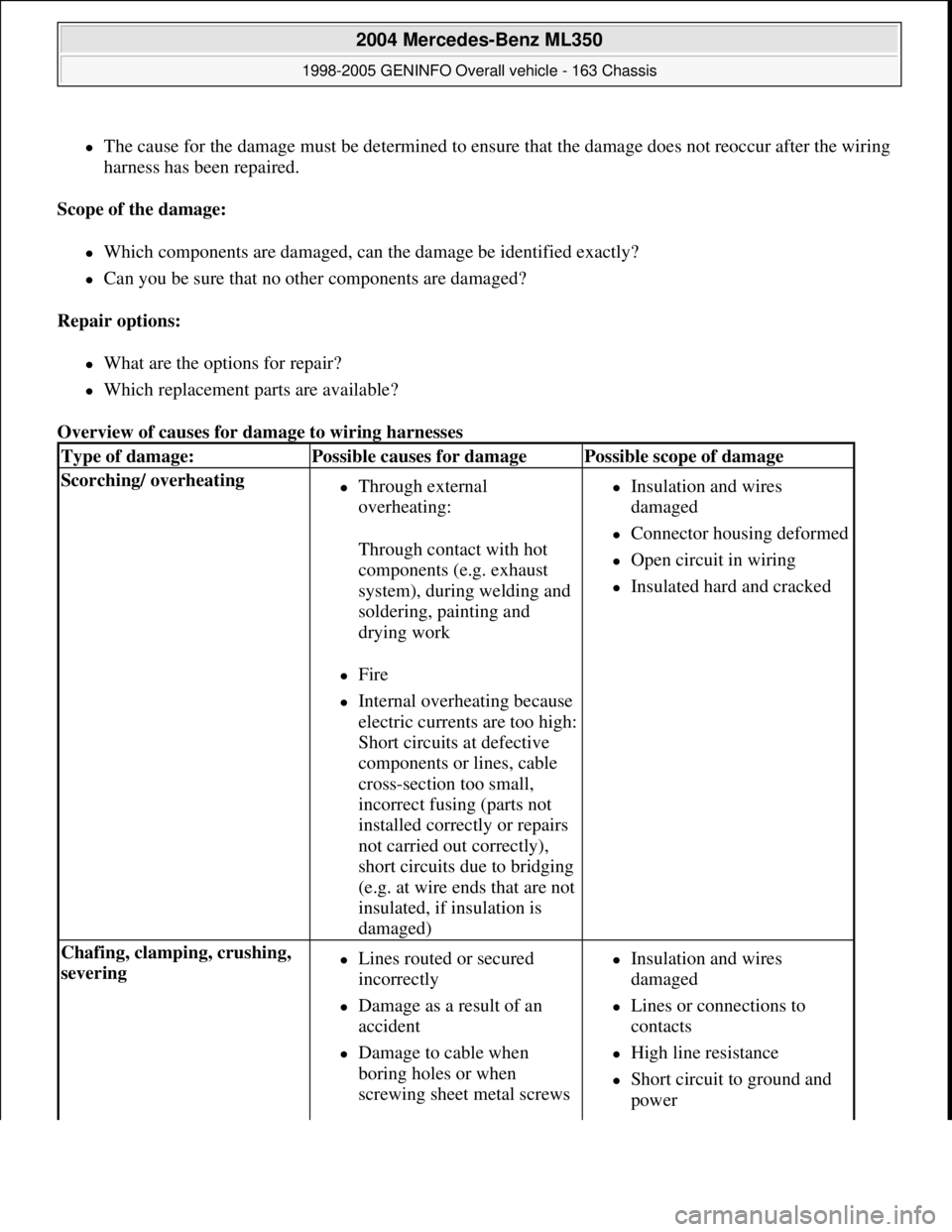
The cause for the damage must be determined to ensure that the damage does not reoccur after the wiring
harness has been repaired.
Scope of the damage:
Which components are damaged, can the damage be identified exactly?
Can you be sure that no other components are damaged?
Repair options:
What are the options for repair?
Which replacement parts are available?
Overview of causes for damage to wiring harnesses
Type of damage:Possible causes for damagePossible scope of damage
Scorching/ overheating Through external
overheating:
Through contact with hot
components (e.g. exhaust
system), during welding and
soldering, painting and
drying work
Fire
Internal overheating because
electric currents are too high:
Short circuits at defective
components or lines, cable
cross-section too small,
incorrect fusing (parts not
installed correctly or repairs
not carried out correctly),
short circuits due to bridging
(e.g. at wire ends that are not
insulated, if insulation is
damaged)
Insulation and wires
damaged
Connector housing deformed
Open circuit in wiring
Insulated hard and cracked
Chafing, clamping, crushing,
severing Lines routed or secured
incorrectly
Damage as a result of an
accident
Damage to cable when
boring holes or when
screwing sheet metal screws
Insulation and wires
damaged
Lines or connections to
contacts
High line resistance
Short circuit to ground and
power
2004 Mercedes-Benz ML350
1998-2005 GENINFO Overall vehicle - 163 Chassis
me
Saturday, October 02, 2010 3:47:44 PMPage 21 © 2006 Mitchell Repair Information Company, LLC.
Page 2879 of 4133
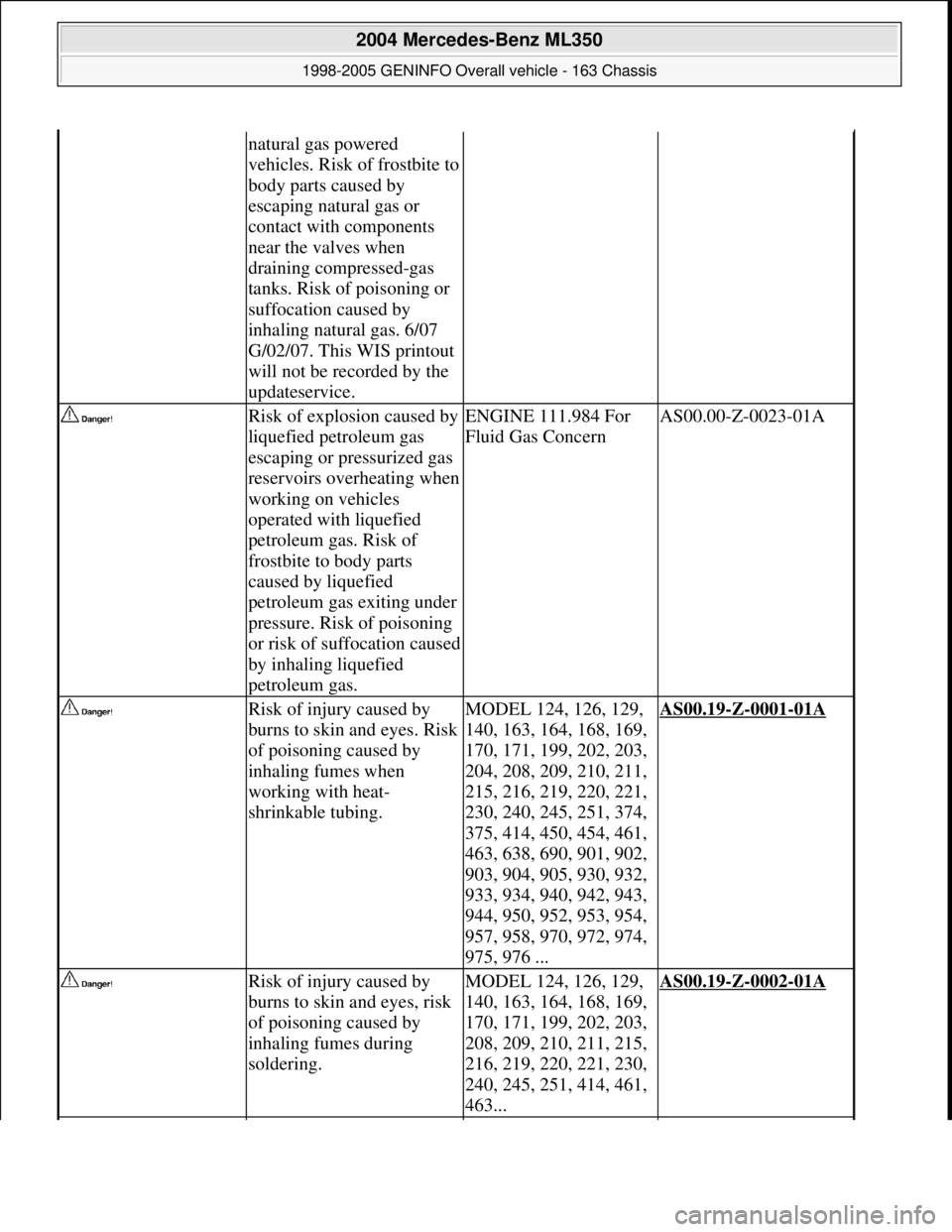
natural gas powered
vehicles. Risk of frostbite to
body parts caused by
escaping natural gas or
contact with components
near the valves when
draining compressed-gas
tanks. Risk of poisoning or
suffocation caused by
inhaling natural gas. 6/07
G/02/07. This WIS printout
will not be recorded by the
updateservice.
Risk of explosion caused by
liquefied petroleum gas
escaping or pressurized gas
reservoirs overheating when
working on vehicles
operated with liquefied
petroleum gas. Risk of
frostbite to body parts
caused by liquefied
petroleum gas exiting under
pressure. Risk of poisoning
or risk of suffocation caused
by inhaling liquefied
petroleum gas.ENGINE 111.984 For
Fluid Gas ConcernAS00.00-Z-0023-01A
Risk of injury caused by
burns to skin and eyes. Risk
of poisoning caused by
inhaling fumes when
working with heat-
shrinkable tubing.MODEL 124, 126, 129,
140, 163, 164, 168, 169,
170, 171, 199, 202, 203,
204, 208, 209, 210, 211,
215, 216, 219, 220, 221,
230, 240, 245, 251, 374,
375, 414, 450, 454, 461,
463, 638, 690, 901, 902,
903, 904, 905, 930, 932,
933, 934, 940, 942, 943,
944, 950, 952, 953, 954,
957, 958, 970, 972, 974,
975, 976 ...AS00.19-Z-0001-01A
Risk of injury caused by
burns to skin and eyes, risk
of poisoning caused by
inhaling fumes during
soldering.MODEL 124, 126, 129,
140, 163, 164, 168, 169,
170, 171, 199, 202, 203,
208, 209, 210, 211, 215,
216, 219, 220, 221, 230,
240, 245, 251, 414, 461,
463...AS00.19-Z-0002-01A
2004 Mercedes-Benz ML350
1998-2005 GENINFO Overall vehicle - 163 Chassis
me
Saturday, October 02, 2010 3:47:48 PMPage 234 © 2006 Mitchell Repair Information Company, LLC.
Page 2881 of 4133
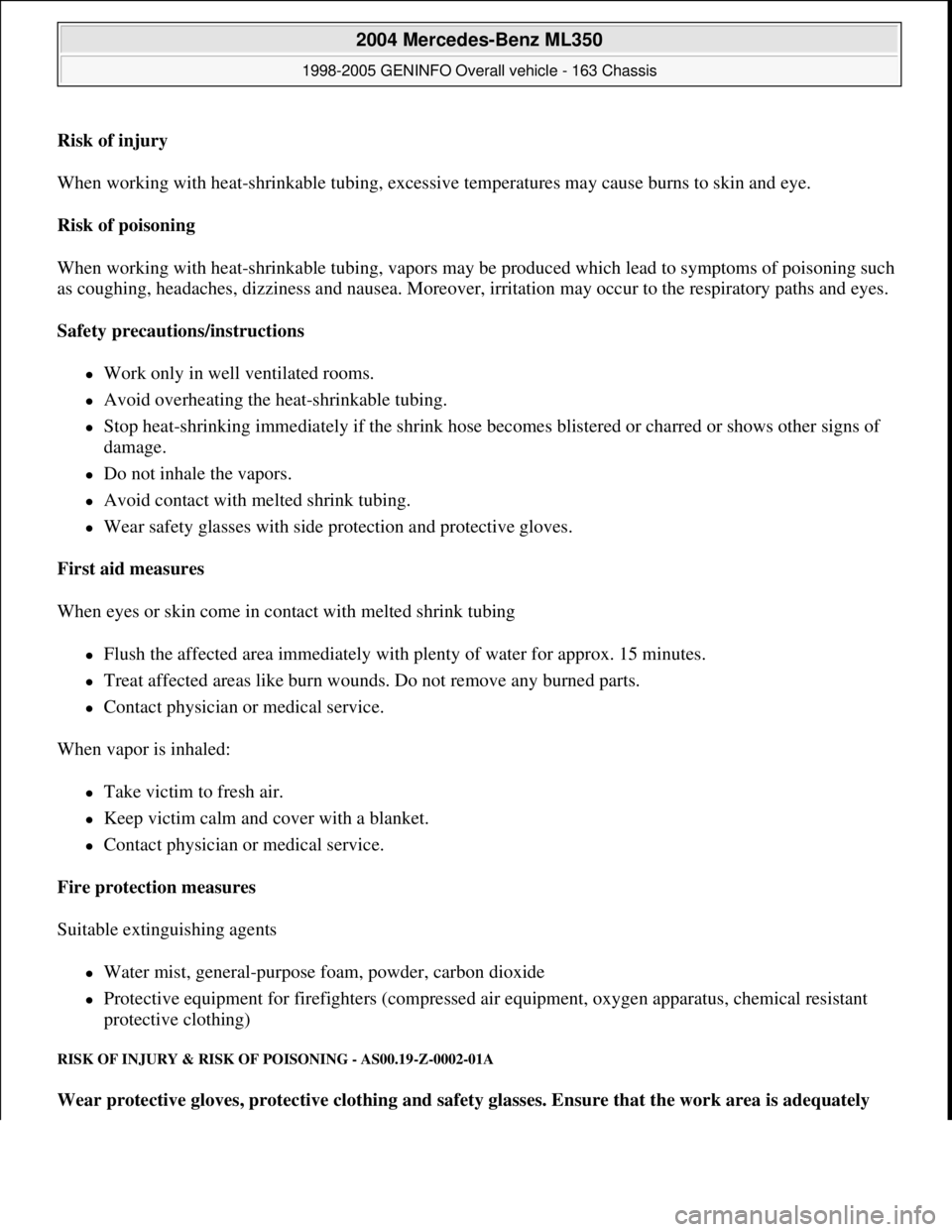
Risk of injury
When working with heat-shrinkable tubing, excessive temperatures may cause burns to skin and eye.
Risk of poisoning
When working with heat-shrinkable tubing, vapors may be produced which lead to symptoms of poisoning such
as coughing, headaches, dizziness and nausea. Moreover, irritation may occur to the respiratory paths and eyes.
Safety precautions/instructions
Work only in well ventilated rooms.
Avoid overheating the heat-shrinkable tubing.
Stop heat-shrinking immediately if the shrink hose becomes blistered or charred or shows other signs of
damage.
Do not inhale the vapors.
Avoid contact with melted shrink tubing.
Wear safety glasses with side protection and protective gloves.
First aid measures
When eyes or skin come in contact with melted shrink tubing
Flush the affected area immediately with plenty of water for approx. 15 minutes.
Treat affected areas like burn wounds. Do not remove any burned parts.
Contact physician or medical service.
When vapor is inhaled:
Take victim to fresh air.
Keep victim calm and cover with a blanket.
Contact physician or medical service.
Fire protection measures
Suitable extinguishing agents
Water mist, general-purpose foam, powder, carbon dioxide
Protective equipment for firefighters (compressed air equipment, oxygen apparatus, chemical resistant
protective clothing)
RISK OF INJURY & RISK OF POISONING - AS00.19-Z-0002-01A
Wear protective gloves, protective clothing and safety glasses. Ensure that the work area is adequately
2004 Mercedes-Benz ML350
1998-2005 GENINFO Overall vehicle - 163 Chassis
me
Saturday, October 02, 2010 3:47:48 PMPage 236 © 2006 Mitchell Repair Information Company, LLC.
Page 3169 of 4133
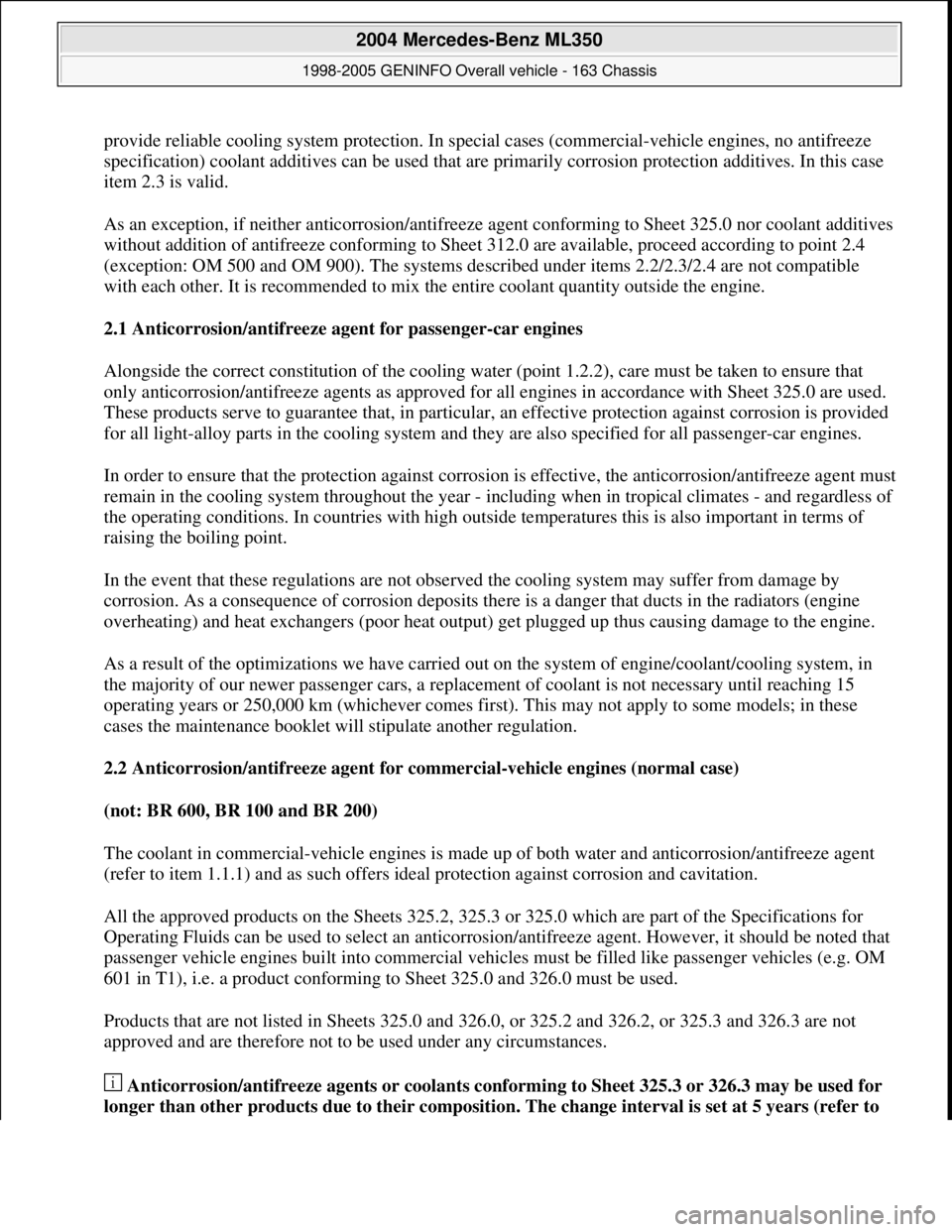
provide reliable cooling system protection. In special cases (commercial-vehicle engines, no antifreeze
specification) coolant additives can be used that are primarily corrosion protection additives. In this case
item 2.3 is valid.
As an exception, if neither anticorrosion/antifreeze agent conforming to Sheet 325.0 nor coolant additives
without addition of antifreeze conforming to Sheet 312.0 are available, proceed according to point 2.4
(exception: OM 500 and OM 900). The systems described under items 2.2/2.3/2.4 are not compatible
with each other. It is recommended to mix the entire coolant quantity outside the engine.
2.1 Anticorrosion/antifreeze agent for passenger-car engines
Alongside the correct constitution of the cooling water (point 1.2.2), care must be taken to ensure that
only anticorrosion/antifreeze agents as approved for all engines in accordance with Sheet 325.0 are used.
These products serve to guarantee that, in particular, an effective protection against corrosion is provided
for all light-alloy parts in the cooling system and they are also specified for all passenger-car engines.
In order to ensure that the protection against corrosion is effective, the anticorrosion/antifreeze agent must
remain in the cooling system throughout the year - including when in tropical climates - and regardless of
the operating conditions. In countries with high outside temperatures this is also important in terms of
raising the boiling point.
In the event that these regulations are not observed the cooling system may suffer from damage by
corrosion. As a consequence of corrosion deposits there is a danger that ducts in the radiators (engine
overheating) and heat exchangers (poor heat output) get plugged up thus causing damage to the engine.
As a result of the optimizations we have carried out on the system of engine/coolant/cooling system, in
the majority of our newer passenger cars, a replacement of coolant is not necessary until reaching 15
operating years or 250,000 km (whichever comes first). This may not apply to some models; in these
cases the maintenance booklet will stipulate another regulation.
2.2 Anticorrosion/antifreeze agent for commercial-vehicle engines (normal case)
(not: BR 600, BR 100 and BR 200)
The coolant in commercial-vehicle engines is made up of both water and anticorrosion/antifreeze agent
(refer to item 1.1.1) and as such offers ideal protection against corrosion and cavitation.
All the approved products on the Sheets 325.2, 325.3 or 325.0 which are part of the Specifications for
Operating Fluids can be used to select an anticorrosion/antifreeze agent. However, it should be noted that
passenger vehicle engines built into commercial vehicles must be filled like passenger vehicles (e.g. OM
601 in T1), i.e. a product conforming to Sheet 325.0 and 326.0 must be used.
Products that are not listed in Sheets 325.0 and 326.0, or 325.2 and 326.2, or 325.3 and 326.3 are not
approved and are therefore not to be used under any circumstances.
Anticorrosion/antifreeze agents or coolants conforming to Sheet 325.3 or 326.3 may be used for
longer than other products due to their composition. The change interval is set at 5 years (refer to
2004 Mercedes-Benz ML350
1998-2005 GENINFO Overall vehicle - 163 Chassis
me
Saturday, October 02, 2010 3:47:57 PMPage 524 © 2006 Mitchell Repair Information Company, LLC.